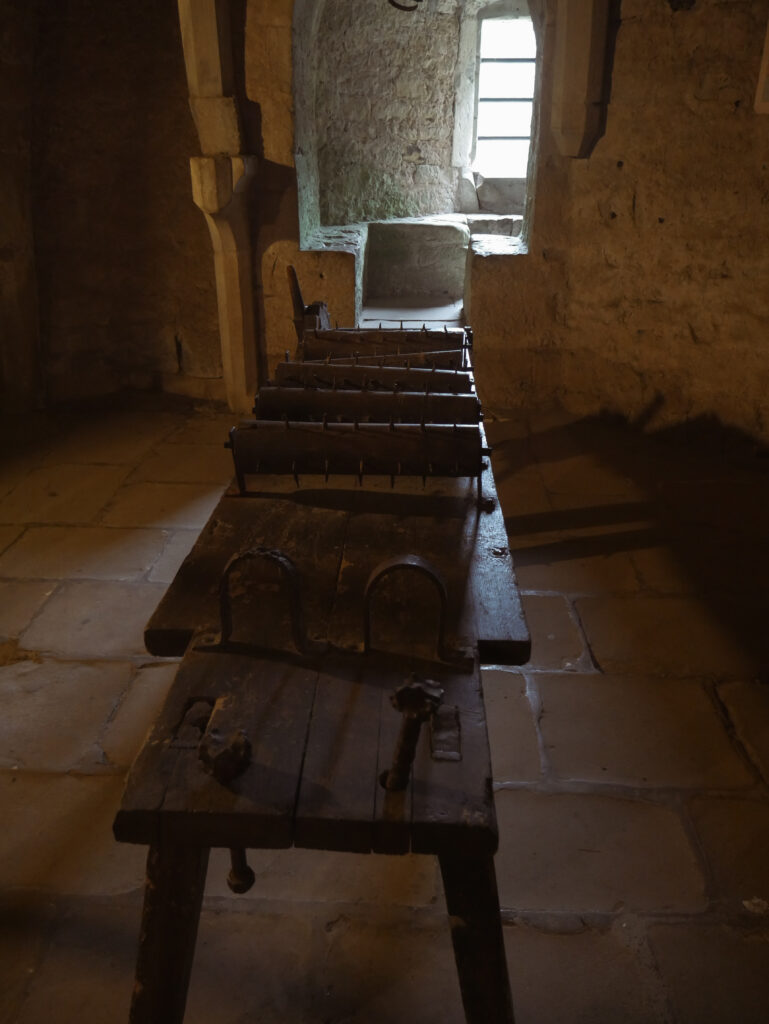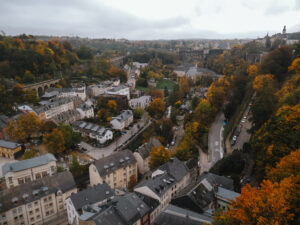Luxembourg’s countryside is dotted with old castles, and the Beaufort Castles are definitely ones worth a visit. Tucked in the woods just outside the town of Beaufort sit the ruins of the Medieval Beaufort Castle and the better-preserved Renaissance Castle. As you walk through the halls of both, you can learn about the history of the castles and the lives of those who lived here over the years. Below, we’ll cover the details needed to plan a visit.

Getting to the Beaufort Castles
Beaufort sits in the Echternach region of Luxembourg not too far away from the German border. To get there, we took the train from Luxembourg Gare Centrale to Ettelbruck, then took bus 191 to Beaufort Op de Gare. However, there are other bus and train combinations available that will get you to the Beaufort Op de Gare or Härewiss stops. Check routes and timetables here. One of the perks of taking public transport in Luxembourg is that all the buses and trains within the country are free!
Once we arrived at the Beaufort Op de Gare bus stop, we walked the 10 minutes to the castles.
If you drive, there is a parking area just across the street from the Medieval Castle entrance.

Tickets
A ticket to tour the Renaissance Castle costs €12 per adult. This also covers entrance to the Medieval Castle and includes a cassero tasting.
If you just wish to visit the Medieval Castle, tickets cost €5 per adult, which also includes a cassero tasting.
Tickets can be bought upon arrival.
The entrance to the Beaufort Castles is also covered by the LuxembourgCard. Learn more here.

Hours
The Medieval Castle is open daily between April and mid-November from 9 a.m. to 6 p.m. The last admission is permitted at 5:15 p.m.
The Renaissance Castle is open by tour only year round. Between April and mid-November, tours take place Thursday through Sunday at 11 a.m. and 4 p.m. If you’d like to take a tour outside of these scheduled options, you may request one by contacting the Beaufort Castle staff. Tours are available in English, German, Luxembourgish, French, and Dutch.
The opening and closing of the Medieval Castle can depend on weather conditions and hours for both castles vary on holidays, so check the webpage or reach out before your visit to confirm that the castles are open.

Exploring the Beaufort Castles
When you arrive at the Beaufort Castles, head through the entrance and get your ticket. We were given a couple brochures providing information on each castle. Near the entrance, there is also a small café and seating area. Restrooms are available nearby too.
The Medieval Castle
The Medieval Beaufort Castle was originally built in the year 1015 with additions being added to it through the mid-1600s. In the 1700s, the castle was left abandoned and it fell into ruin. It had already fallen into a state of neglect when the Renaissance Castle was built next to it in the 1640s. A new owner took over the Beaufort Castles in 1928, uncovering and restoring the ruins. The Medieval Castle was open to the public in 1932.

We began our visit at the Medieval Castle, arriving when it opened with the intention of exploring the ruins before our 11 a.m. tour of the Renaissance Castle. We followed the map given to us at the entrance, reading about the history and significance of different parts of the castle as we walked through it. Some of these include the water tower, various defense features, dungeon, kitchen, knight’s hall, and more.

After taking our time to walk through the ruins, we met our group near the bridge to the Renaissance Castle to begin our tour.
The Renaissance Castle
As mentioned above, the Renaissance Castle was built in the 1640s by Baron Jean de Beck who had purchased the Medieval Castle but decided to build a new castle to live in instead. The property came into the hands of the Linckels family who occupied the castle until Anne-Marie Linckels-Volmer passed away in 2012. The castle has remained largely intact and unchanged over the course of over 360 years.

As we toured the complex, we got a little insight into what life in the castle was like. The living areas contain furniture, art, and other details that keep the memory of the place alive. We were also able to walk through the gardens, kitchen, stables, and distillery. Our guide taught us about the production of cassero, a liqueur made of black currents cultivated on the land near the castle. The visit to the Beaufort Castles ended with a cassero sample of our choice. It was quite delicious!

…
We really enjoyed exploring the Beaufort Castles and learning about their history. We also liked how different the two castles were.

If you’re looking to extend your day trip, there’s a pretty trail that leads by the small lake and into the woods near the castle parking area. We did want to enjoy some of the stunning countryside in this area of Luxembourg, so we walked down this trail a bit before heading towards Berdorf to hike a portion of the Mullerthal Trail system.
Like this Post? Pin it!




